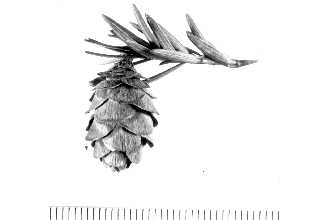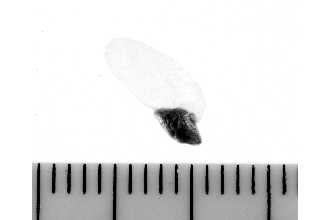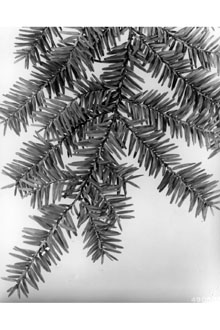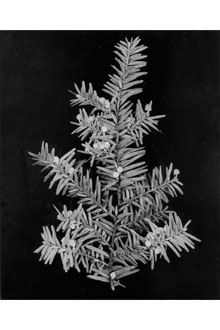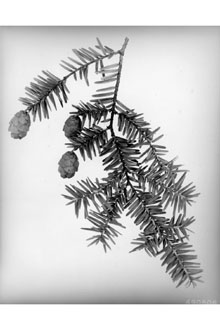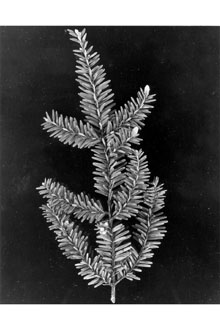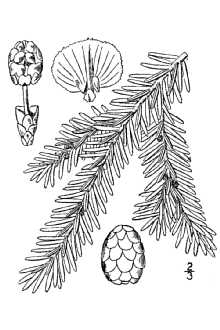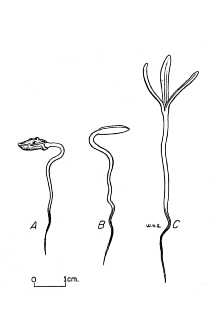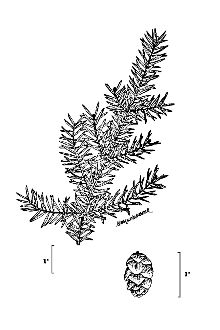Eastern Hemlock
Scientific Name: Tsuga canadensis (L.) Carrière
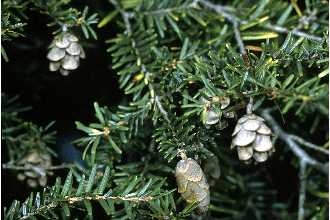
| General Information | |
|---|---|
| Usda Symbol | TSCA |
| Group | Gymnosperm |
| Life Cycle | Perennial |
| Growth Habits | Tree |
| Native Locations | TSCA |
Plant Guide
Alternate Names
Canada hemlock, hemlock spruce
Uses
Industry: Eastern hemlock was early valued for its bark, an important source of tannin for the leather industry. Trees were felled and stripped of their bark, which was then milled for tannin extraction. To simplify stripping the bark and turning the logs, trees were often felled into lakes. Many of these logs were much later extracted from northern lakes and milled. The wood has been used for light framing, roofing, boxes and crates, and pulping, but it tends to be brittle and eastern hemlock is not presently important as a timber tree. Commercial stands have been greatly reduced by prior harvesting and lack of restocking. Ethnobotanic: American Indians used the cambium as the base for breads and soups or mixed it with dried fruit and animal fat for pemmican. Natives and white settlers also made tea from hemlock leaves, which have a high vitamin C content. Conservation: Eastern hemlock can be used as a specimen, screen, or group planting, and it can be sheared over time into a formal evergreen hedge, which is densely leafy all the way to the ground (due to its full shade tolerance), although as a hedge it must be repeatedly pruned to keep it in size. It has a naturally open growth habit – if bought with a dense canopy effect, it may have been repeatedly sheared at the nursery (or Christmas tree farm). Numerous cultivars of eastern hemlock have been developed, including compact shrubs, dwarfs, form mutants (weeping, fastigiate, prostrate, etc.), color mutants (variegated), and graceful trees. The wild type apparently also is common in cultivation. Eastern hemlock stands are considered important as shelter and cover for white-tailed deer and other wildlife species, such as turkey, ruffed grouse, and others. © R.A. Seelig Botany Dept., NMNH, Smithsonian Institution @ PLANTS
Status
Please consult the PLANTS Web site and your State Department of Natural Resources for this plant’s current status, such as, state noxious status and wetland indicator values.
Description
General: Pine family (Pinaceae). Native trees to 30 meters tall, with a broadly conic crown, the branches often drooping at the ends and “feathery;” twigs yellow-brown, densely pubescent. Bark brownish, scaly and fissured. Needles evergreen, flat, mostly appearing 2-ranked, (5-)15-20(-25) mm long, narrowed to a petiole-like base and set on peg-like projections, the lower surface waxy, with 2 broad, conspicuous stomatal bands (like pale lines), the upper surface shiny-green to yellow-green, the margins minutely toothed, especially toward apex. Seed cones ovoid, 1.5-2.5 cm long, borne near the branch tips, hanging. The common name pertains to its distribution in eastern North America. Variation within the species: various studies have recorded physiological and morphological variation within the species, but no major discontinuities have been found to suggest that named entities should be recognized. The geographic distribution of eastern hemlock completely overlaps that of Carolina hemlock (Tsuga caroliniana), which differs in its high elevation habitats, leaves mostly spreading all directions from the twigs, and more elongate seed cones. Distribution: Eastern hemlock is a species of the northeastern and Appalachian regions of North America: from New Brunswick and Nova Scotia to southern Quebec and Ontario, south to northern Georgia and Alabama, west in the lake states to Minnesota with outliers in southern Michigan, western Ohio, and southern Indiana. Many disjunct populations, probably glacial relicts, occur east of the Appalachians in the middle Atlantic states. For current distribution, please consult the Plant Profile page for this species on the PLANTS Web site.
Adaptation
Eastern hemlock grows from about sea level to 1500 meters. In the more southern parts of its range, eastern hemlock occurs only where there is drainage of cool, moist air -- on moist rocky ridges, valleys and ravines, hillsides, and lakeshores. In the northern hardwood forest, it is found on a greater variety of sites, including low rolling hills and glacial ridges. Eastern hemlock most commonly grows in mixed stands with species such as white pine, northern red oak, sugar maple, American beech, yellow birch, and white ash.
Establishment
Eastern hemlocks begin to produce cones at about age 15 in vigorous trees or much later in suppressed trees. There is a high frequency of cone crops and individual trees have a long duration of cone production (excellent cone production has been reported for trees more than 450 years old), but the viability of seed usually is low. Seeds are particularly easily damaged by drying. The best conditions for germination and seedling establishment are under a 70-80% crown cover on an exposed, partially decomposed layer. Otherwise, regeneration is restricted to rotten logs, stumps, and mounds that normally have warmer surfaces and better moister retention than the forest floor. Eastern hemlock is the most shade tolerant of all tree species and individuals may remain in the understory in natural stands for 25-400 years. After a plant reaches 1-2 meters in height, the root system has reached a depth not radically afffected by surface drying, and release from overstory competition may greatly increase annual growth. In general, eastern hemlock is a slow-growing tree that may take 250 to 300 years to reach maturity and may live for 900 years or more.
Management
Eastern hemlock generally does not tolerate nutrient-poor soils, wet soils or poorly drained sites, prolonged drought, prolonged heat, sun scorch, windy and exposed sites, aerial pollution, or winter salt spray, Drought is probably the most serious damaging agent to the species, especially during the seedling stage, Damping-off fungi and root rots also are seriously damaging to young plants, Use soil moisture sensors to measure the soil moisture of Eastern Hemlock., Containerized plants are best for transplanting – move into sites that are cool, well-drained, and wind-protected, in partial sun to partial shade, Good drainage is essential for transplant success -- the porosity of the soil should be improved with peat moss or sand, with the root ball elevated about 2" to 4" above the surrounding soil grade, A shallow root system makes trees highly susceptible to wind-throw when exposed through timber cutting or planted in open sites, Plants should be staked for the first two or three years following transplant, to prevent wind-throw, Saplings and small trees are highly susceptible to damage from fire because of the thin bark, and root injury often occurs from high intensity fires because of heavy litter concentration, The most severe insect pest is the Asian hemlock woolly adelgid, a phloem-feeding insect that causes branch dieback and tree decline, Trees typically die after several years of adelgid infestation, Cultivars, Improved and Selected Materials (and area of origin) These plant materials are readily available from commercial sources, Contact your local Natural Resources Conservation Service (formerly Soil Conservation Service) office for more information, Look in the phone book under ”United States Government,” The Natural Resources
Conservation
Service will be listed under the subheading “Department of Agriculture.”
References
Godman, R.M. & K. Lancaster 1990. Tsuga canadensis. Pp. 604-612, IN: R.M. Burns and B.H. Honkala. Silvics of North America. Volume 1. Conifers. USDA Forest Service Agric. Handbook 654, Washington, D.C. <http://willow.ncfes.umn.edu/silvics_manual/Table_of_contents.htm> Taylor, R.J. 1993. Tsuga. Pp. 362-365, IN: Flora of North America, north of Mexico. Vol. 2, Pteridophytes and Gymnosperms. Oxford Univ. Press, New York. <http://hua.huh.harvard.edu/cgi-bin/Flora/flora.pl?FLORA_ID=12395> USDA, NRCS 2000. The PLANTS database. 21SEP2000. National Plant Data Center, Baton Rouge, Louisiana. <http://plants.usda.gov>
Plant Traits
Growth Requirements
| Temperature, Minimum (°F) | -33 |
|---|---|
| Adapted to Coarse Textured Soils | Yes |
| Adapted to Fine Textured Soils | No |
| Adapted to Medium Textured Soils | Yes |
| Anaerobic Tolerance | None |
| CaCO3 Tolerance | None |
| Cold Stratification Required | Yes |
| Drought Tolerance | Low |
| Fertility Requirement | Medium |
| Fire Tolerance | Medium |
| Frost Free Days, Minimum | 80 |
| Hedge Tolerance | High |
| Moisture Use | Medium |
| pH, Maximum | 5.7 |
| pH, Minimum | 4.2 |
| Planting Density per Acre, Maxim | 1200 |
| Planting Density per Acre, Minim | 300 |
| Precipitation, Maximum | 55 |
| Precipitation, Minimum | 32 |
| Root Depth, Minimum (inches) | 28 |
| Salinity Tolerance | None |
| Shade Tolerance | Tolerant |
Morphology/Physiology
| Bloat | None |
|---|---|
| Toxicity | None |
| Resprout Ability | No |
| Shape and Orientation | Erect |
| Active Growth Period | Spring and Summer |
| C:N Ratio | High |
| Coppice Potential | No |
| Fall Conspicuous | No |
| Fire Resistant | No |
| Flower Color | Yellow |
| Flower Conspicuous | No |
| Foliage Color | Dark Green |
| Foliage Porosity Summer | Dense |
| Foliage Porosity Winter | Dense |
| Foliage Texture | Fine |
| Fruit/Seed Conspicuous | No |
| Nitrogen Fixation | None |
| Low Growing Grass | No |
| Lifespan | Long |
| Leaf Retention | Yes |
| Known Allelopath | No |
| Height, Mature (feet) | 105.0 |
| Height at 20 Years, Maximum (fee | 22 |
| Growth Rate | Slow |
| Growth Form | Single Stem |
| Fruit/Seed Color | Brown |
Reproduction
| Vegetative Spread Rate | None |
|---|---|
| Small Grain | No |
| Seedling Vigor | Medium |
| Seed Spread Rate | Slow |
| Fruit/Seed Period End | Fall |
| Seed per Pound | 187200 |
| Propagated by Tubers | No |
| Propagated by Sprigs | No |
| Propagated by Sod | No |
| Propagated by Seed | Yes |
| Propagated by Corm | No |
| Propagated by Container | Yes |
| Propagated by Bulb | No |
| Propagated by Bare Root | Yes |
| Fruit/Seed Persistence | No |
| Fruit/Seed Period Begin | Summer |
| Fruit/Seed Abundance | High |
| Commercial Availability | Routinely Available |
| Bloom Period | Mid Spring |
| Propagated by Cuttings | Yes |
Suitability/Use
| Veneer Product | No |
|---|---|
| Pulpwood Product | Yes |
| Post Product | No |
| Palatable Human | No |
| Palatable Browse Animal | Medium |
| Nursery Stock Product | Yes |
| Naval Store Product | No |
| Lumber Product | Yes |
| Fuelwood Product | Medium |
| Fodder Product | No |
| Christmas Tree Product | No |
| Berry/Nut/Seed Product | No |

